Understanding Walk-In Cooler Dimensions: A Complete Guide
Walk in cooler dimensions typically range from 6'×6' to 12'×12' with standard ceiling heights of 7'6" or 8'. Here's a quick reference for the most common sizes:
| Size | Internal Cubic Footage | Storage Capacity (approx.) |
|---|---|---|
| 6'×6' | 270 cu ft | 8,100 lbs |
| 8'×8' | 550 cu ft | 16,500 lbs |
| 10'×8' | 671 cu ft | 20,130 lbs |
| 10'×12' | 777 cu ft | 23,310 lbs |
| 12'×12' | 918 cu ft | 27,540 lbs |
When selecting a walk-in cooler, dimensions are about more than just measurements. The right size ensures optimal temperature control, energy efficiency, and sufficient storage capacity while complying with regulatory requirements.
Walk-in coolers are constructed from modular panels, typically 4 inches thick, providing an R-value of approximately R-28 for standard coolers. These panels use cam-lock fasteners for secure connections, creating an airtight seal that maintains consistent internal temperatures.
Standard door openings are typically 34"×76", though larger 36" and 48" options are available for facilities requiring cart or pallet access. Remember to account for the additional external space needed for proper ventilation - a minimum of 2 inches clearance around all sides is recommended.
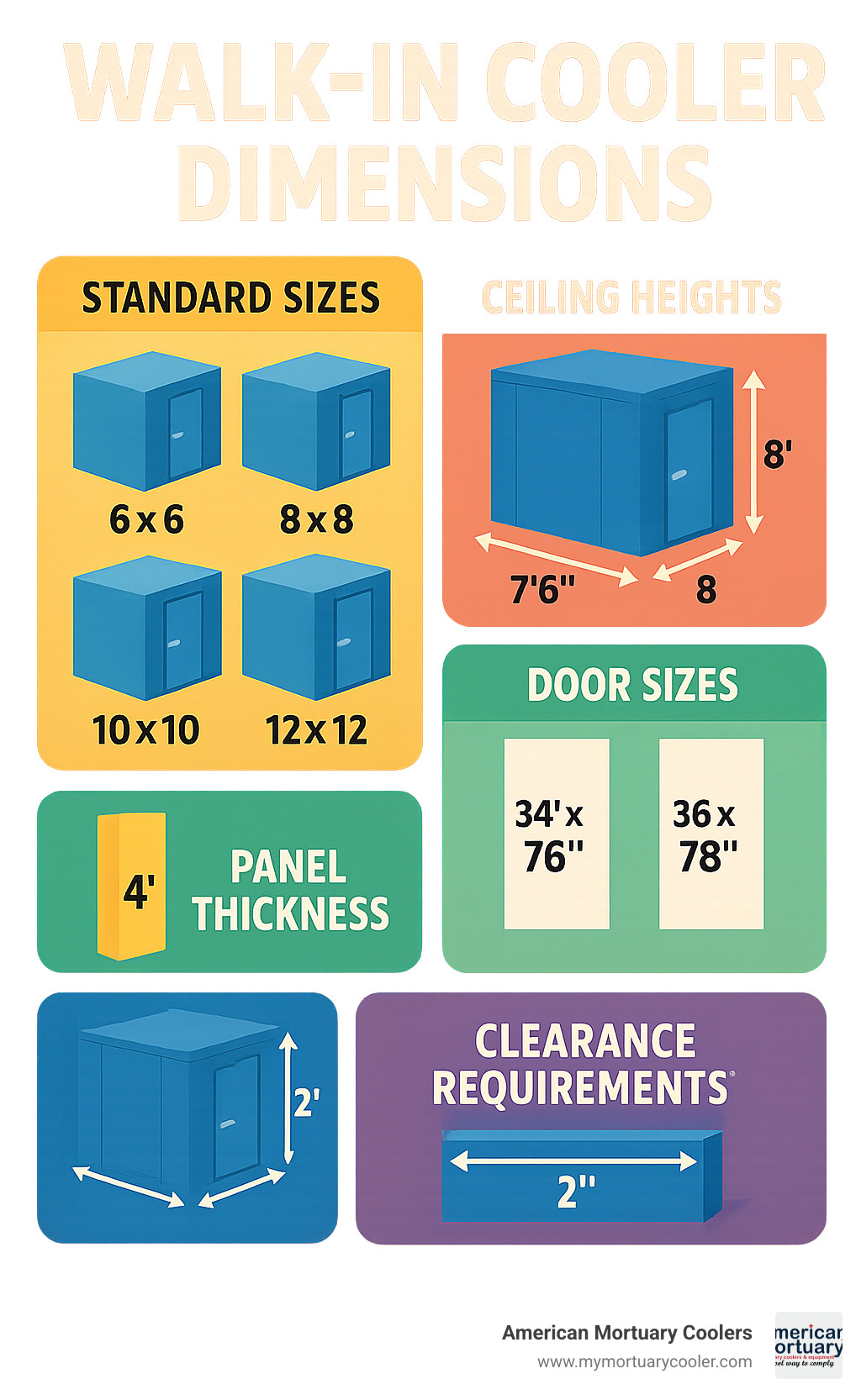
Walk in cooler dimensions terms to learn:
What Makes a Walk-In Cooler Different?
Walk-in coolers create entire cold storage environments that maintain temperatures between 35°F-45°F with remarkable precision, unlike standard refrigerators.
The real magic lies in the construction. Walk in cooler dimensions revolve around modular panel systems that create an insulated room rather than a standalone appliance. These panels boast impressive R-values between R-28 and R-32, far superior to standard refrigerators.
Walk-ins are equipped with commercial-grade refrigeration systems specifically sized for the space they need to cool. This means they can bounce back to the perfect temperature quickly, even when staff are constantly opening and closing the door during busy periods.
The FDA's food storage guidelines emphasize that keeping foods consistently below 40°F is essential for safety. Walk-in coolers excel at this critical task, maintaining these safe temperatures with exceptional reliability.
Core Components & Materials
The heart of any walk-in cooler's dimensional integrity comes down to several key components:
Insulated panels are typically 4 inches thick with foamed-in-place urethane insulation sandwiched between metal skins. This construction achieves that impressive R-28 value for coolers (and even higher R-32 for freezers).
Walk in cooler dimensions maintain their integrity thanks to cam-lock fasteners spaced no more than 48 inches apart. When tightened with a hex wrench, these fasteners create an airtight seal between panels – crucial for temperature control and energy efficiency.
Inside, you'll find vapor-proof lighting fixtures that are UL-approved and sealed against moisture. High-quality magnetic door gaskets create a tight seal around the entire perimeter, preventing cold air from escaping while still allowing easy operation.
When floor panels are included, they're built to support serious weight – typically rated for 600 to 1,200 pounds per square foot. These consist of ¾-inch exterior grade plywood bonded to metal and foamed in place.
Indoor vs. Outdoor Footprints
Indoor Walk-In Coolers need at least 2 inches of clearance around all sides for proper ventilation. Most commercial buildings can easily accommodate their standard height of 7'6" or 8'. Indoor units typically mount refrigeration systems on top or along side walls.
Outdoor Walk-In Coolers require weather protection including rain roofs, membrane coverings, and sloped designs to shed water effectively. They require low-ambient kits to function properly across varying outdoor temperatures.
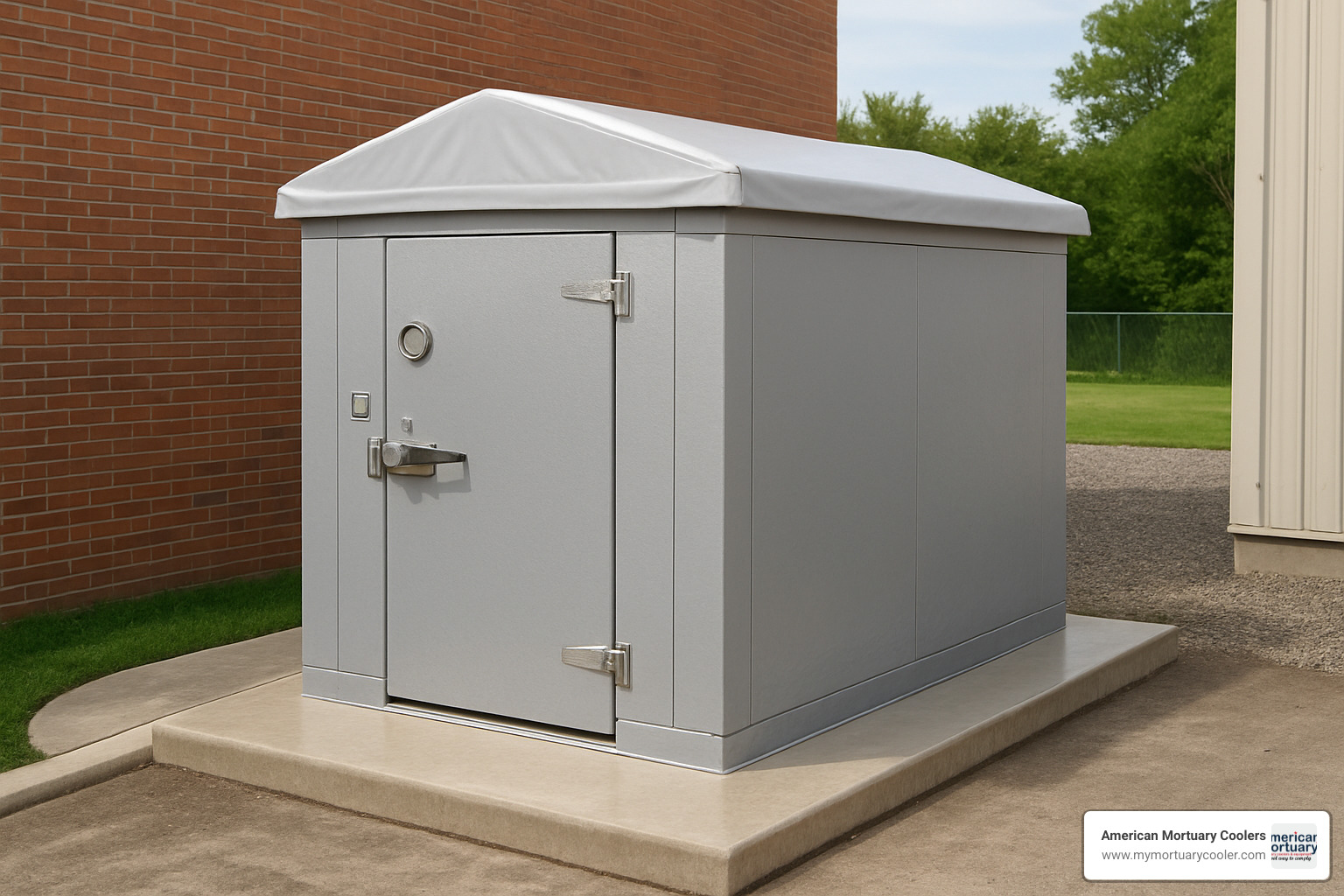
Outdoor walk in cooler dimensions almost always include heavy-duty flooring rated for 1,200 lbs per square foot. They're also outfitted with vinyl roof caps, rain hoods, and additional sealing measures to keep moisture at bay.
Site preparation is crucial for outdoor installations. The ground must be level within ¼ inch per 10 feet, and a properly constructed concrete pad is typically required.
Standard Walk-In Cooler Dimensions & Sizing Charts
When planning your walk-in cooler, getting the dimensions right isn't just about measurements—it's about making smart decisions for your budget and space. Walk in cooler dimensions are typically sold in nominal sizes, which might differ from what you'll actually get once assembled.
Standard sizes are both more affordable and ship much faster than custom dimensions. These ready-to-go options are built with modular panels that snap together, making installation straightforward.
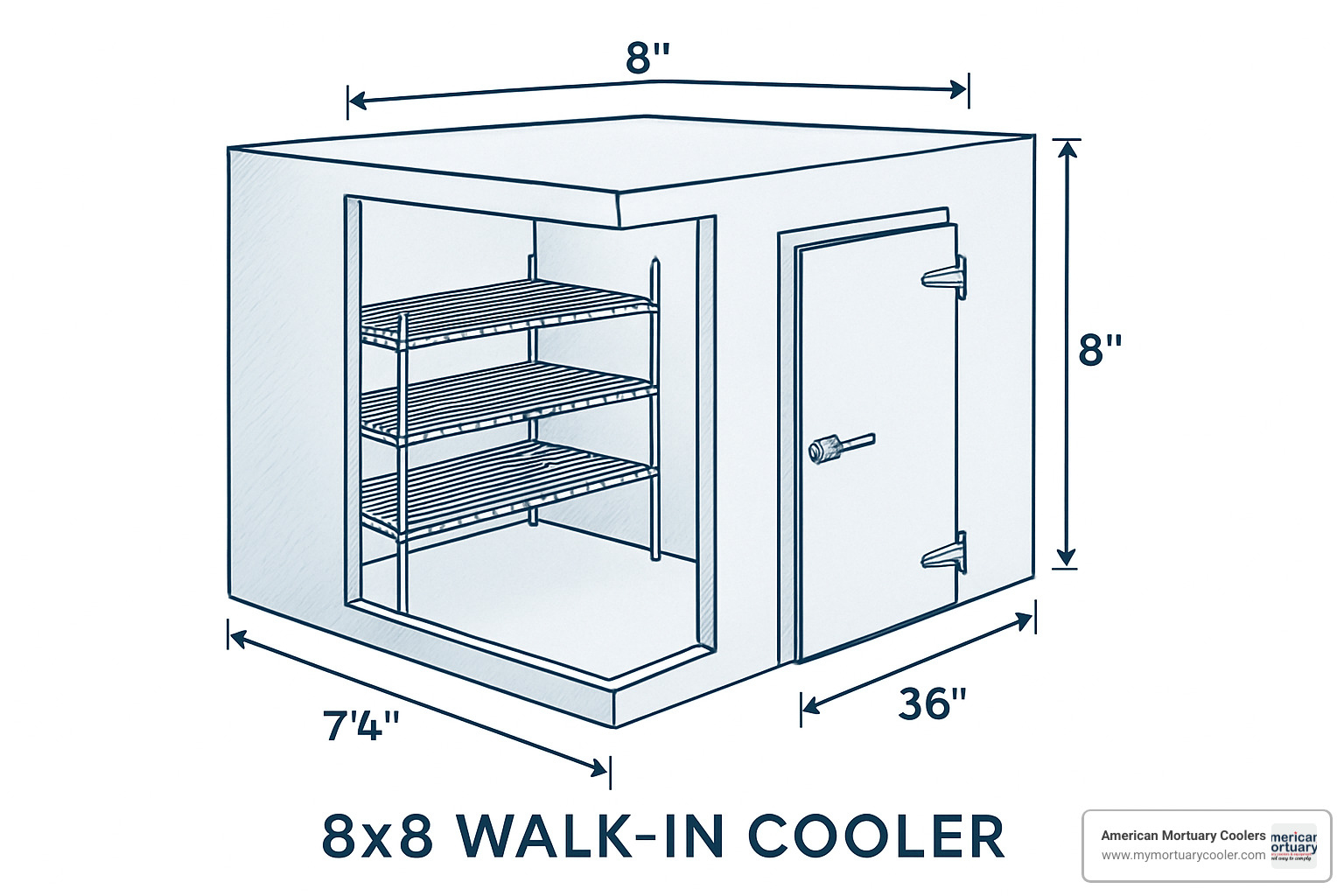
Common Walk in Cooler Dimensions Chart
Here's a chart of the most popular walk in cooler dimensions that come as standard configurations:
| Nominal Size | Actual Assembled Size | Internal Volume | Approx. Storage Capacity | Typical Application |
|---|---|---|---|---|
| 6' × 6' | 5'8" × 5'8" × 7'6" | 270 cu ft | 8,100 lbs | Small cafés, coffee shops |
| 8' × 8' | 7'8" × 7'8" × 7'6" | 550 cu ft | 16,500 lbs | Small restaurants, floral shops |
| 10' × 8' | 9'8" × 7'8" × 7'6" | 671 cu ft | 20,130 lbs | Medium restaurants, convenience stores |
| 10' × 12' | 9'8" × 11'8" × 7'6" | 777 cu ft | 23,310 lbs | Large restaurants, small grocery stores |
| 12' × 12' | 11'8" × 11'8" × 7'6" | 918 cu ft | 27,540 lbs | Grocery stores, institutional kitchens |
A helpful rule of thumb: one cubic foot of well-organized cooler space can hold about 30 pounds of product. Adding shelves will reduce your usable storage volume by about 20-30%.
Ceiling Heights & Door Options
While everyone focuses on floor space, ceiling height deserves just as much attention:
The standard 7'6" height is the most budget-friendly option and works for most applications. The premium 8'0" height gives you extra storage capacity and improves air circulation. For specialized needs, custom heights of 9'0" or taller are available.
Your ceiling height choice affects where you can place your refrigeration system. For ceiling-mounted units, you'll need about 2 feet of clearance above for proper airflow.
The standard passage door is 34" × 76", but many businesses opt for the 36" × 78" "Super-Door" for more clearance. If you're moving pallets or carts, the 48" × 78" wide door might be your best bet.
For freezer applications, doors include heater wire around the edges to prevent frost buildup and ensure a proper seal. These heated doors typically come with a pressure relief port that equalizes pressure differences.
How to Choose the Right Walk-In Cooler Dimensions for Your Business
Picking the perfect walk in cooler dimensions feels a bit like Goldilocks searching for the right porridge. Too small, and you'll be cramming products in like sardines. Too large, and you're cooling empty air while watching utility bills soar.
Start by taking an honest inventory of what you need to store right now. Industry rule: one cubic foot of well-organized walk-in space holds about 30 pounds of product.
But don't just plan for today - look 10-15 years down the road. Will you be handling more products? Expanding your offerings? It's often more economical to invest in a slightly larger unit now than to replace your entire cooler just a few years later.
Your budget matters too. Larger units cost more upfront and consume more energy over time. Finding that sweet spot – large enough for growth but not wastefully oversized – will save you thousands in the long run.
For more sizing specifics, check out our Beginners Guide to Walk-In Cooler Sizing Charts.
Measurement & Space Planning
Getting accurate measurements is crucial. Grab a tape measure and record your available space dimensions carefully.
Always allow for proper clearance – at minimum, leave 2 inches around all sides of the cooler for ventilation. For outdoor installations, you'll need even more space for maintenance access. And don't forget about door swing! Your cooler door typically needs 36-48 inches of clearance to open fully.
Consider your workflow too. If you'll be using carts or equipment inside, plan for aisles at least 40 inches wide.

Don't forget about your refrigeration equipment needs. Ceiling-mounted units need about 2 feet of clearance above them, while side-mounted units require appropriate space on the mounting wall.
Walk in Cooler Dimensions Mistakes to Avoid
Oversizing your cooler leads to higher upfront costs and inflated energy bills month after month. Oversized coolers can even develop temperature consistency issues if the refrigeration system isn't properly matched to the space.
Undersizing creates its own problems. A too-small cooler limits your storage capacity and can restrict your business growth. Overcrowded conditions impede proper airflow, potentially leading to warm spots and product spoilage.
Ignoring future needs is another common pitfall. Businesses evolve, seasonal demands fluctuate, and product lines expand.
Don't overlook workflow considerations either. Poor door placement can disrupt your entire operation's flow. Inadequate aisle width turns simple retrieval tasks into frustrating exercises.
Finally, regulatory requirements may influence your dimensions. Health department regulations, ADA compliance standards, and local building codes all might dictate certain aspects of your cooler's size and configuration.
Customization, Organization & Industry-Specific Needs
Walk-in coolers aren't one-size-fits-all solutions. Thanks to their modular design, walk in cooler dimensions can be customized to meet your specific needs, with many manufacturers offering customization in one-foot increments.
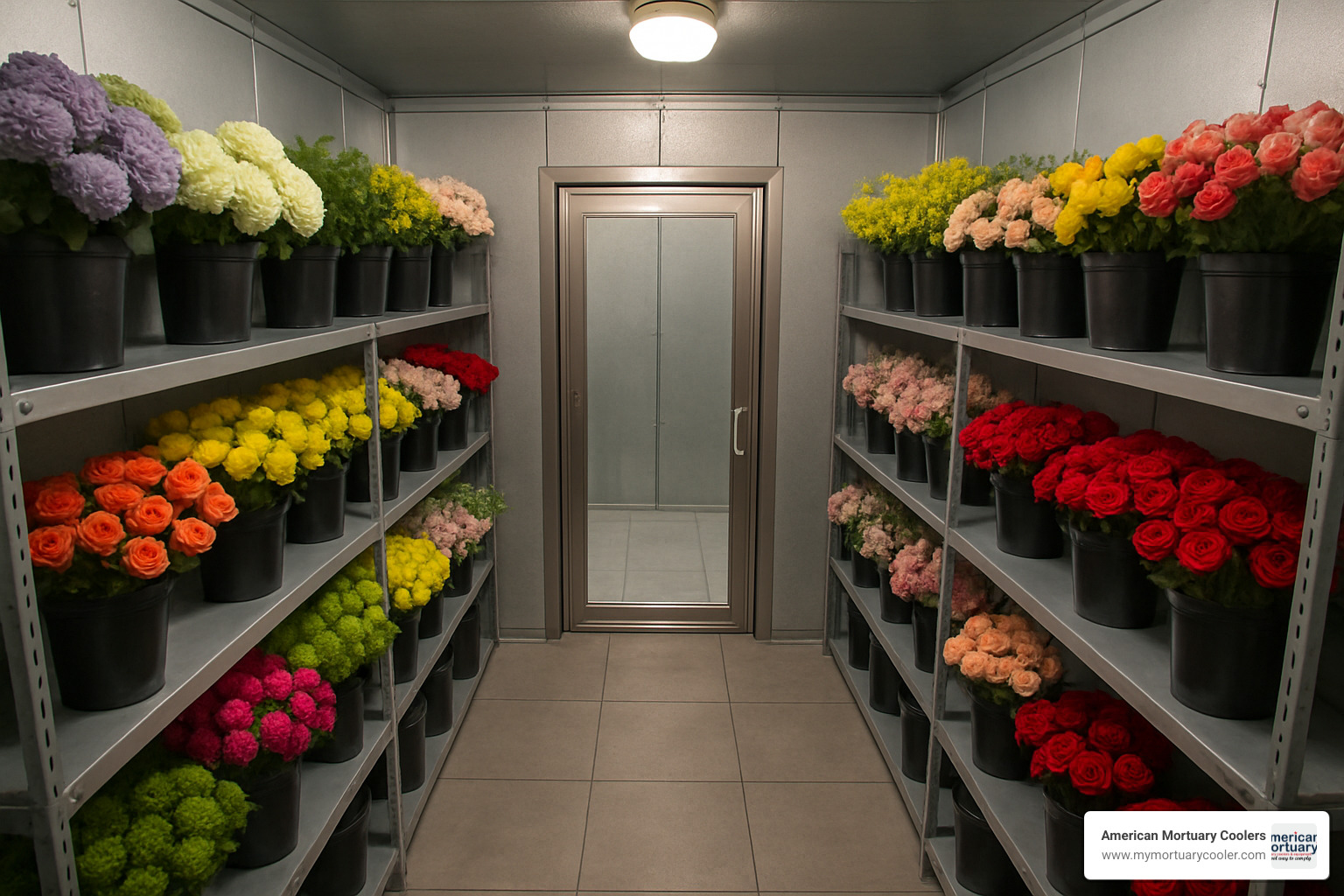
Different industries have unique cold storage requirements:
In the mortuary industry, funeral homes need dimensions that accommodate standard stretchers and carts. Most find that widths of at least 8 feet with depths of 10-12 feet provide the ideal space. We typically recommend 8-foot ceiling heights to create comfortable working conditions while ensuring proper air circulation.
Florists need to showcase their arrangements while keeping them fresh. Many flower shops choose walk-ins with glass doors or display windows. Dimensions typically range from 6'×6' units for boutique shops to 8'×10' coolers for larger operations.
Restaurants and commercial kitchens balance storage needs with limited kitchen space. A busy café might start with an 8'×8' cooler, while high-volume establishments often need 10'×12' or larger units. Door placement is especially critical for smooth workflow between prep areas and cold storage.
Medical facilities and laboratories require precision temperature control. These specialized applications often need custom dimensions to fit specific equipment or sample storage needs. Many opt for combination cooler/freezer units that provide separate temperature zones within a single footprint.
Grocery stores and retail operations typically need the largest dimensions, often 12'×12' or bigger, with multiple door options. The ideal setup often includes glass display doors facing customers with standard doors in the back for easy restocking.
For more custom options, see our guide to custom walk-in fridges.
Shelving & Internal Layout Effects on Dimensions
Smart internal layout can make even a modest-sized cooler feel spacious and functional.
Most commercial operations use NSF-approved shelving in depths of 18", 21", or 24". Adding shelving typically reduces your usable volume by 20-30% compared to empty space.
For comfortable access, plan for 30-36" aisle width (or 40" if using carts). Leave 12-18" between your top shelf and ceiling for proper air circulation.
Most clients find success with a perimeter shelving layout, keeping the center open for easy movement. Whatever layout you choose, never block evaporator fans or refrigeration components with products.
For frequently used doors, consider installing strip curtains to minimize temperature loss during busy periods.
Insulation Thickness & Energy Efficiency
The thickness of your cooler's insulation affects both external and internal dimensions - and your long-term operating costs.
Most walk-in coolers come with 4" thick panels, providing R-28 to R-29 insulation for coolers and R-32 for freezers. For businesses looking to maximize energy savings, 5" thick panels (R-35 to R-36) or premium 6" thick panels (R-42 to R-48) are worth considering.
Insulation thickness directly impacts your interior space. For example, if you order a nominal 8'×8' cooler with 4" thick panels, your actual interior dimensions will be approximately 7'4"×7'4".
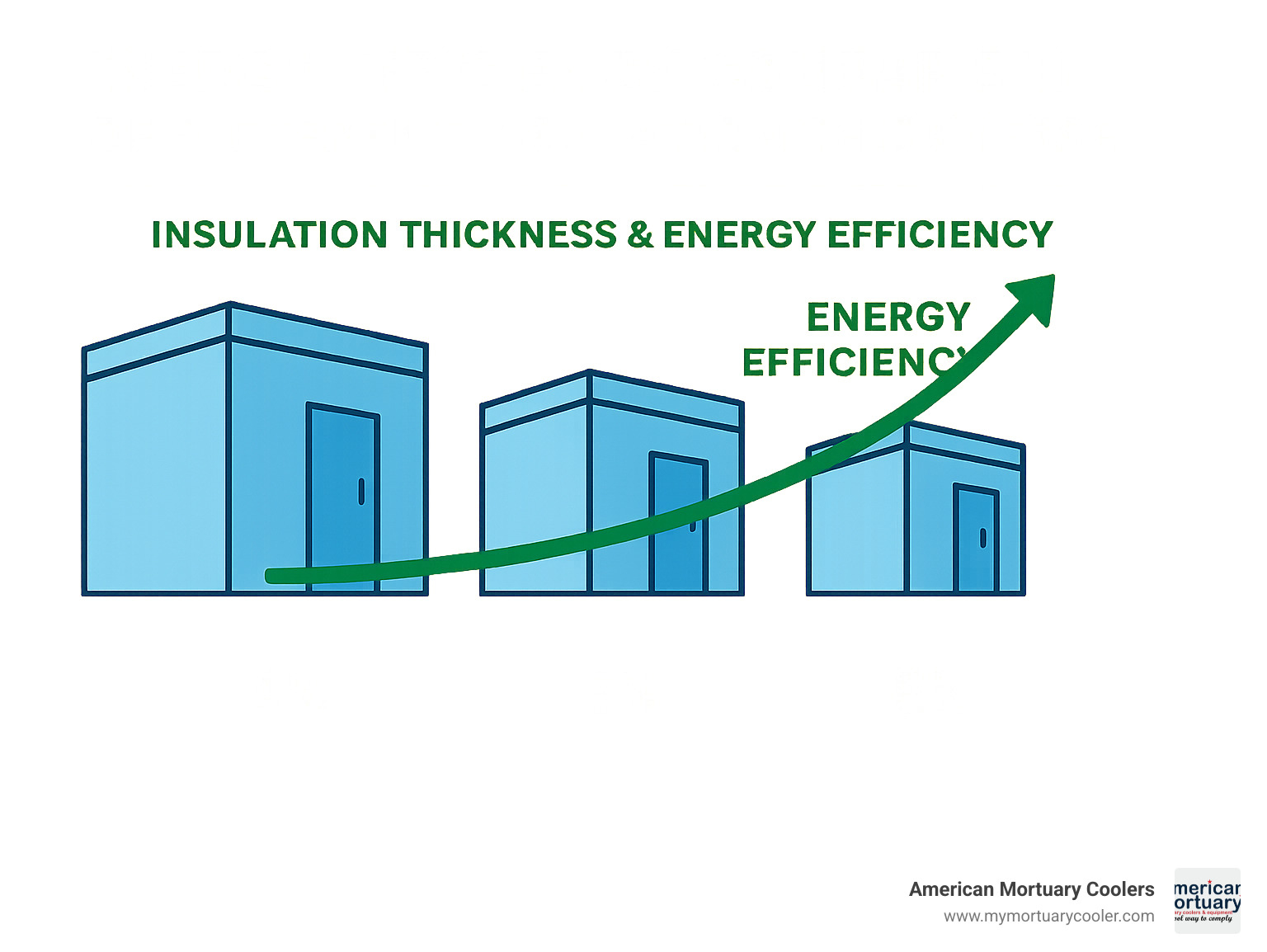
The energy efficiency benefits of thicker insulation can be substantial:
- Better insulated units may allow for smaller, less expensive refrigeration systems
- Many utility companies offer rebates for high-efficiency walk-in coolers
- Lower monthly energy bills add up to significant savings over time
For businesses in hot climates or areas with high utility costs, investing in thicker insulation panels often pays for itself. Check out the Save On Energy program for information about potential utility rebates.
Frequently Asked Questions about Walk-In Cooler Dimensions
What walk-in cooler dimensions do I need for X pounds of product?
In the cold storage industry, we typically work with this rule of thumb: one cubic foot of well-organized walk-in cooler space can hold about 30 pounds of product.
To calculate your needs, simply divide your total product weight by 30:
Required cubic feet = Total product weight (lbs) ÷ 30
For example, if your funeral home needs to store 15,000 pounds of product: 15,000 ÷ 30 = 500 cubic feet. This translates to a walk-in cooler with dimensions around 8'×8'×8' (512 cubic feet) or 10'×7'×7'6" (525 cubic feet).
Shelving typically reduces your usable storage space by 20-30%, so factor that in. Consider adding an extra 10-15% capacity to accommodate future growth.
Are ceiling-mounted units different in height requirements?
Yes! When planning for walk in cooler dimensions with ceiling-mounted refrigeration, you'll need to think vertically as well as horizontally.
Standard walk-in coolers typically have ceiling heights of either 7'6" or 8', but ceiling-mounted refrigeration units need about 24 inches of additional clearance above the unit for proper airflow and maintenance access.
If you're working with limited overhead space, remote refrigeration systems place the condensing unit outside or in a separate mechanical room, with only the evaporator coil inside the cooler. These systems need just 2 inches of clearance between the ceiling and the top of the evaporator.
Can I expand my walk-in cooler later without full replacement?
Good news – one of the biggest advantages of modular panel construction is flexibility for the future! Many customers start with a size that meets their current needs and expand later as their business grows.
The most common expansion method is removing one end wall and adding additional floor, wall, and ceiling panels to extend the length or width.
If future expansion might be in your plans, here are some helpful tips:
- Position your cooler with at least one end accessible for future expansion
- Select a refrigeration system with some extra capacity or one that can be upgraded
- Install doors on walls that won't need to be removed during expansion
There are some practical limitations. You might need to upgrade your refrigeration system to handle the increased volume. Also, panels from different manufacturers aren't always compatible, so it's best to expand with components from your original supplier.
Conclusion
Selecting the right walk in cooler dimensions isn't just a technical decision—it's one that will impact your daily operations, energy bills, and overall satisfaction for years to come.
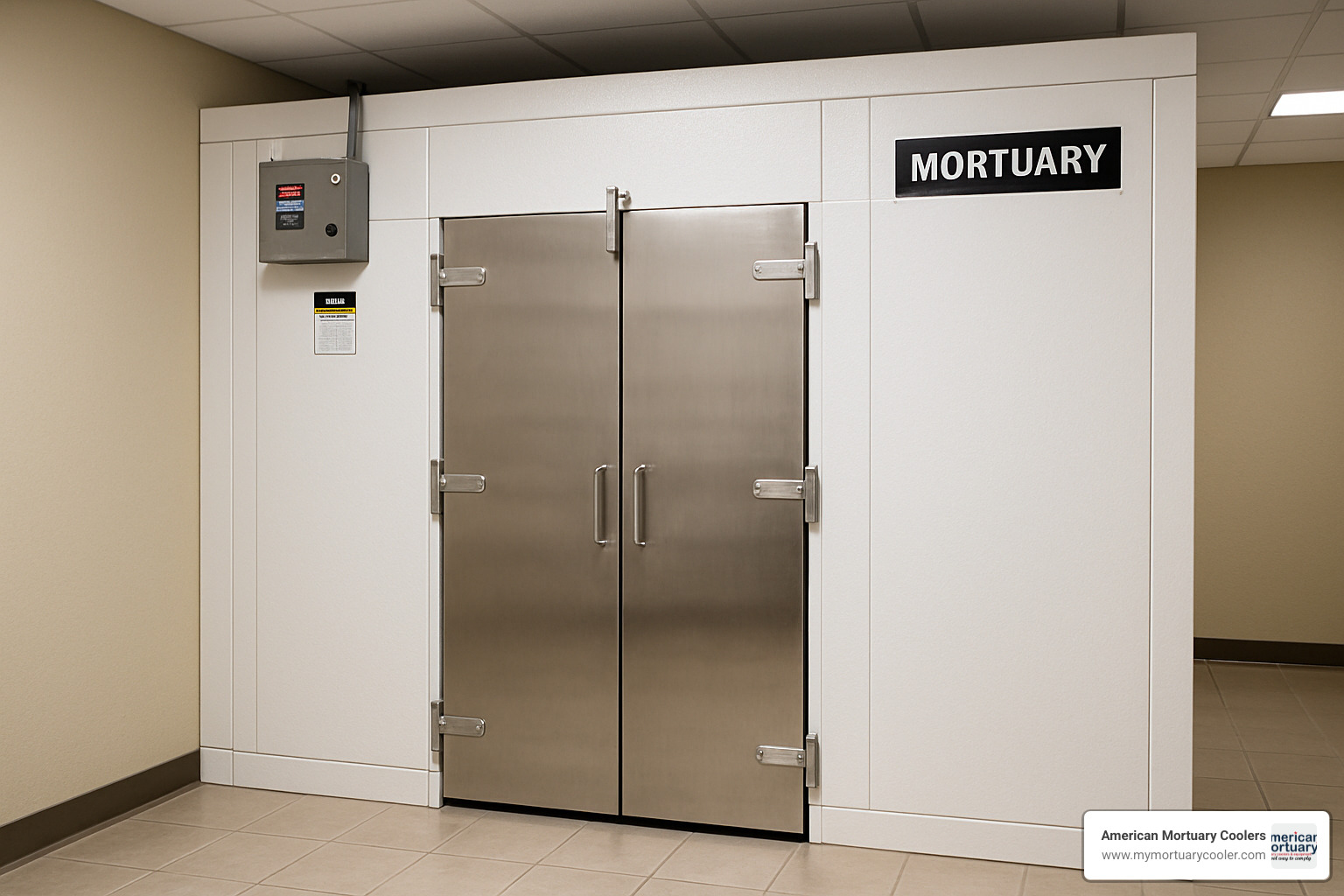
When it comes down to it, finding your perfect walk-in cooler is about balancing several key factors. Standard sizes ranging from 6'×6' units to spacious 12'×12' models will cover most needs, but the right fit might be something in between or even custom-built.
Think about storage capacity realistically. That industry guideline of 30 pounds per cubic foot is helpful, but only if you're organizing your space efficiently. Planning for future growth is something too many businesses overlook. Think about where you'll be in 10-15 years, not just next month.
Energy efficiency directly impacts your bottom line. A properly sized unit maintains consistent temperatures without overworking, saving you money every month on utility bills.
Different industries have their own unique requirements. The walk in cooler dimensions that work perfectly for a florist might be completely impractical for a mortuary. At American Mortuary Coolers, we understand these nuances deeply. Based in Tennessee, we craft cold storage systems specifically designed for funeral homes and other specialized industries, delivering directly to customers across the 48 contiguous states.
A properly sized cooler isn't just about fitting your products—it's about creating a workflow that makes sense, meeting regulatory requirements, and ensuring your equipment serves you well for decades.
For those specifically in the funeral industry, check out our ultimate guide to choosing a walk-in mortuary cooler for additional insights custom to your unique needs.
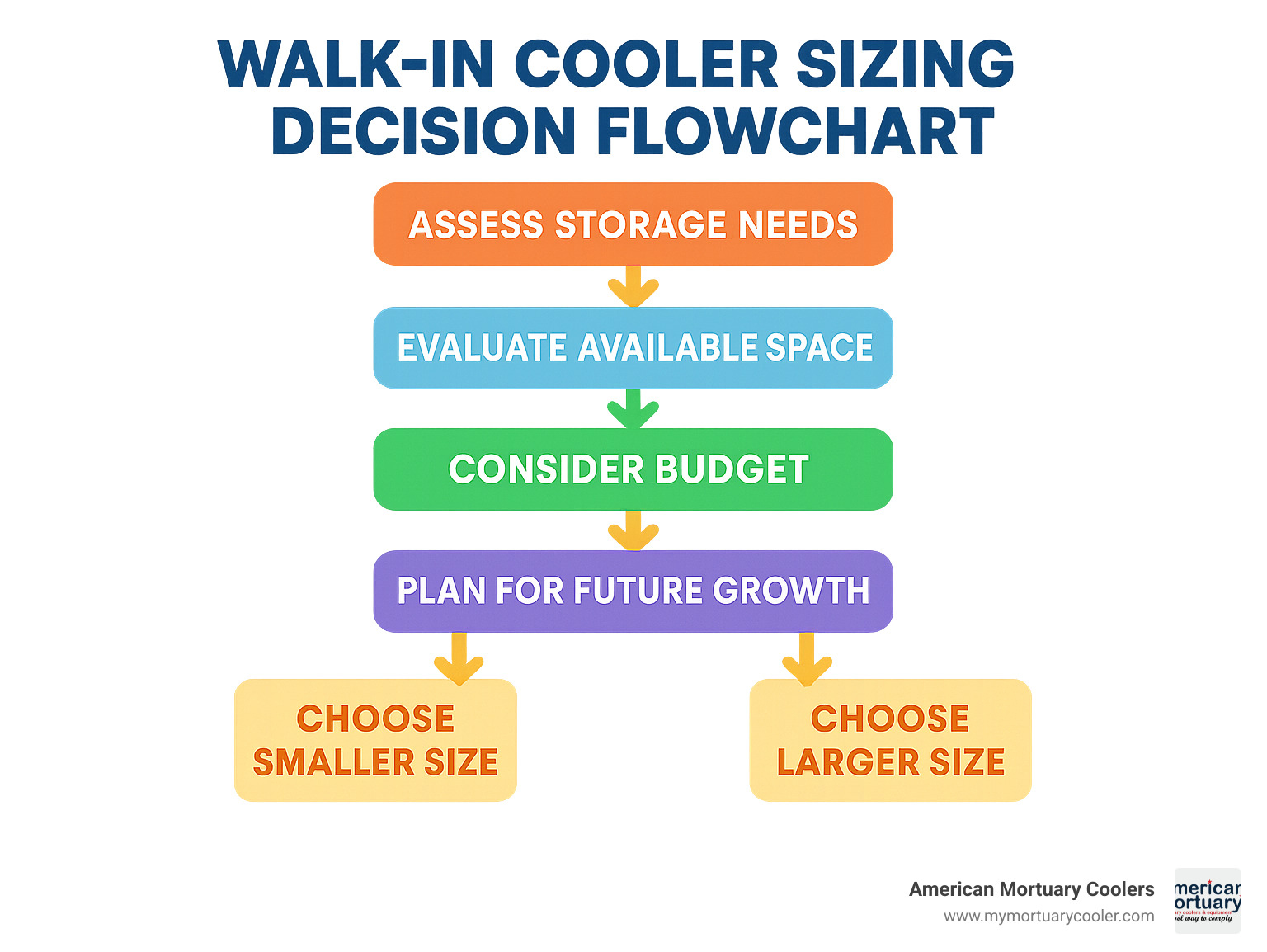
The right walk in cooler dimensions go beyond just fitting into your available space—they create an efficient, compliant, and future-proof solution that serves your specific needs year after year.


















